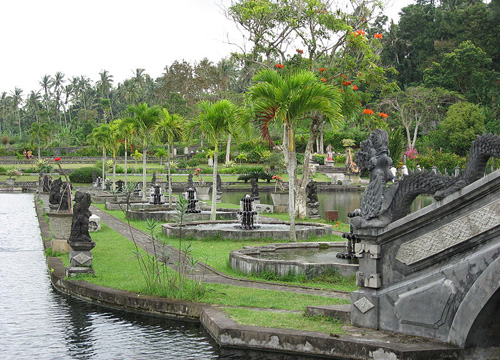Balinese Temples & Palaces
Besakih Temple
Besakih Temple or Pura Besakih is a temple complex in the village of Besakih on the slopes of Mount Agung in eastern Bali, known as a mother temple of Bali. It is the most important, the largest and holiest temple of Hindu religion in Bali and one of a series of Balinese temples. Perched nearly 1000 meters up the side of Gunung Agung, it is an extensive complex of 23 separate but related temples with the largest and most important being Pura Penataran Agung.
The temple is built on six levels, terraced up the slope. The entrance is marked by a candi bentar (split gateway), and beyond it the Kori Agung is the gateway to the second courtyard.
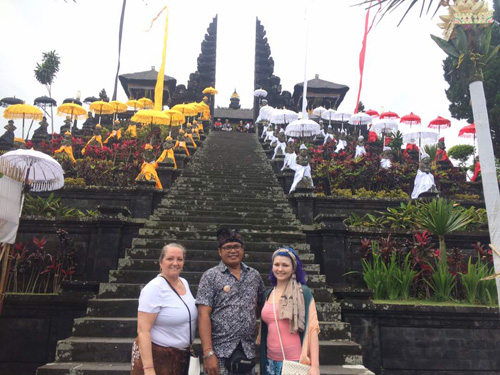
Tanah Lot Temple
The Tanah Lot temple was built and has been a part of Balinese mythology for centuries. The temple is one of seven sea temples around the Balinese coast. Each of the sea temples was established within eyesight of the next to form a chain along the south-western coast. In addition to Balinese mythology, the temple was significantly influenced by Hinduism.
At the base of the rocky island, venomous sea snakes are believed to guard the temple from evil spirits and intruders. The temple is purportedly protected by a giant snake, which was created from Nirartha's selendang (a type of sash) when he established the island.
The area leading to Tanah Lot is highly commercialized and people are required to pay to enter the area. To reach the temple, visitors must walk through a set of Balinese market-format souvenir shops which cover each side of the path down to the sea. On the mainland clifftops, restaurants have also been provided for tourists.

Ulun Danu Temple
Pura Ulun Danu Beratan, or Pura Bratan, is a major Shaivite water temple on Bali. The temple complex is located on the shores of Lake Bratan in the mountains near Bedugul. Water temples serve the entire region in the outflow area; downstream there are many smaller water temples that are specific to each irrigation association (subak).
Built in 1633, this temple is used for offerings ceremony to the Balinese water, lake and river goddess Dewi Danu, due to the importance of Lake Bratan as a main source of irrigation in central Bali. The 11-storey pelinggih meru in the complex is dedicated to Shiva and his consort Parvathi. Buddha's statue is also enshrined in this temple.
Lake Bratan is known as the Lake of Holy Mountain due to the fertility of this area. Located 1200 m above sea level, it has a cold tropical climate.
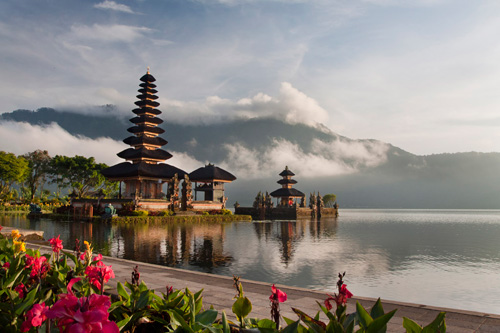
Tirta Empul Temple
Tirta Empul Temple was founded around a large water spring in 962 A.D. during the Warmadewa dynasty (10th-14th centuries). The name of the temple comes from the ground water source named "Tirta Empul".
The spring is the source of the Pakerisan river. The temple is divided into three sections: Jaba Pura (front yard), Jaba Tengah (central yard) and Jeroan (inner yard). Jaba Tengah contains 2 pools with 30 showers which are named accordingly: Pengelukatan, Pebersihan and Sudamala dan Pancuran Cetik (poison).
The temple is dedicated to Vishnu, another Hindu god name for the supreme consciousness Narayana. On a hill overlooking the temple, a modern villa was built for President Sukarno's visit in 1954. The villa is currently a rest house for important guests.
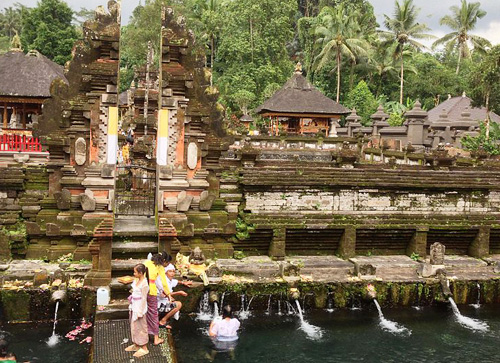
Uluwatu Temple
Uluwatu Temple is a Balinese sea temple in Uluwatu. The temple is regarded as one of the sad kahyangan and is dedicated to Sang Hyang Widhi Wasa in his manifestation as Rudra.
Though a small temple was claimed to have existed earlier, the structure was significantly expanded by a Javanese sage, Empu Kuturan in the 11th Century. Another sage from East Java, Dang Hyang Nirartha is credited for constructing the padmasana shrines and it is said that he attained moksha here, an event called ngeluhur ("to go up") locally. This has resulted in the temple's epithet Luhur.
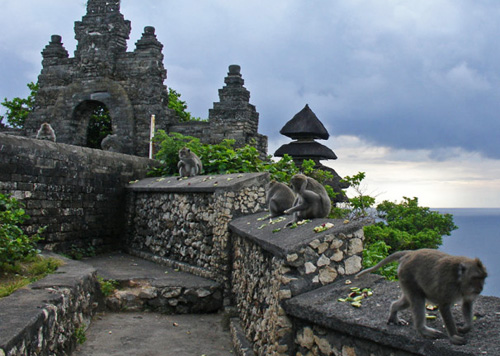
Gunung Kawi Temple
Gunung Kawi is an 11th-century temple and funerary complex in Tampaksiring north east of Ubud in Bali, that is spread across either side of the Pakerisan river. It comprises 10 rock-cut candi (shrines) that are carved into some 7-metre-high (23 ft) sheltered niches of the sheer cliff face. These funeral monuments are thought to be dedicated to King Anak Wungsu of the Udayana dynasty and his favourite queens.
On the east side there are five temples that are dedicated, according to one theory, to King Udayana, his queen Mahendradatta, and their sons Airlanga, Anak Wungsu, and Marakata. The temples on the west side are dedicated, according to the same theory, to the king's minor queens or concubines.
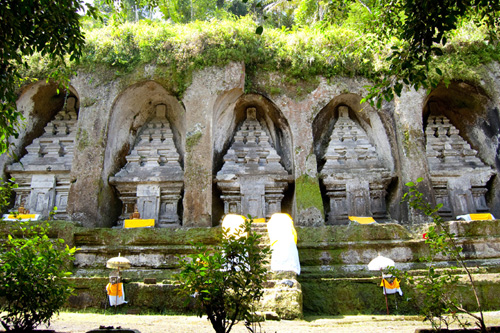
Goa Gajah Temple
Goa Gajah temple or Elephant Cave, is located on the island of Bali near Ubud. Built in the 9th century, it served as a sanctuary
At the facade of the cave is a relief of various menacing creatures and demons carved right into the rock at the cave entrance. The primary figure was once thought to be an elephant, hence the nickname Elephant Cave. The site is mentioned in the Javanese poem Desawarnana written in 1365. An extensive bathing place on the site was not excavated until the 1950s. These appear to have been built to ward off evil spirits.

Ujung Water Palace
Ujung Water Palace is a former palace in Karangasem Regency, Bali. Now, this palace also known as Ujung Park or Sukasada Park. It is located approximately 5 kilometres from Amlapura. In the Dutch East Indies era, this place known by the name Waterpaleis. The palace three large pools. In the middle of the pool, there is the main building named Gili Bale, connected to the edge of the pool by bridge.
Ujung Water Palace was built by the King of Karangasem, I Gusti Bagus Jelantik, who holds Anak Agung Agung Ketut Karangasem Anglurah. This palace is a privately owned by Karangasem Royal. It was built in 1909 on the initiative of Anak Agung Anglurah. The architect was a Dutch van Den Hentz and a Chinese Loto Ang. This development also involves the undagi (Balinese architect). This palace is actually the development from Dirah Pool which has been built in 1901 The construction was completed in 1921. In 1937, Taman Ujung Karangasem inaugurated with a marble stele inscribed with the text in Latin and Balinese script and also two languages, Malay and Balinese. It was destroyed almost entirely by the eruption of Mount Agung in 1963 and earthquake in 1975.
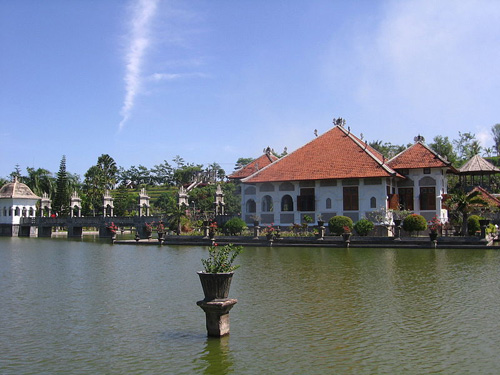
Tirta Gangga Royal Palace
Tirta Gangga is a former royal palace in eastern Bali, about 5 kilometres from Karangasem, near Abang. It is noted for its water palace, owned by Karangasem Royal.
Tirta Gangga literally means water from the Ganges and it is a site of some reverence for the Hindu Balinese. Strictly, the name refers to the water palace built in 1948 by the Raja of Karangasem, Anak Agung Agung Anglurah Ketut Karangasem. It is, however, the name widely used to refer to the general area which includes the water palace and the lush rural areas around. Tirta Gangga water palace is a maze of pools and fountains surrounded by a lush garden and stone carvings and statues. The one hectare complex was built in 1946 by the late King of Karangsem but was destroyed almost entirely by the eruption of nearby Mount Agung in 1963. It has been lovingly re-built and restored and has an air of authentic royal magnificence.
The centrepiece of the palace is an eleven tiered fountain and there are many beautiful carvings and statues adorning the gardens. The area around Tirta Gangga is noted for its rice paddy terraces.
